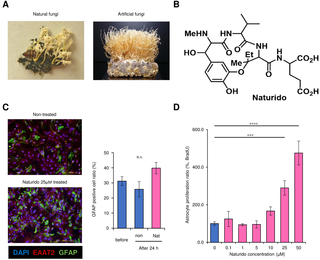
岩手大学:“毛虫真菌”物质的贡献:痴呆症和阿尔茨海默氏病
岩手大学:生物茧研究所
寄生有蚕蛾“冬虫夏草” up的蘑菇
发现一种叫做“ Natreed”的物质有助于改善痴呆症和阿尔茨海默氏病。
岩手大学的风险投资公司“生茧研究所”(盛冈市)宣布。
脑疾病的治疗:
将来,“它可以用于治疗痴呆,帕金森氏病和精神分裂症等脑部疾病。”
除了岩手大学
大阪市立大学
九州大学
与岩手医科大学合作进行。
该研究结果于1月28日(日本时间)在美国科学杂志“ PLOS ONE”(电子版)上发表。
螺旋藻冬虫夏草:
2010年,生物茧研究所将蚕蛾冬虫夏草的提取物送给了年老的老鼠。
结果,他宣布“控制记忆的大脑海马体上的疤痕已经修复”。
充满信心的不断发展的研究表明,蚕蛾虫草中含有致病性物质。
2013年,我们确定了Naturido。
Naturido:
之后,研究进行了大约6年。
他发现:“自然界具有促进神经细胞生长的作用。”
读卖新闻在线
https://www.yomiuri.co.jp/science/20210203-OYT1T50037/
A novel cyclic peptide (Naturido) modulates glia–neuron interactions in vitro and reverses ageing-related deficits in senescence-accelerated mice
The use of agents that target both glia and neurons may represent a new strategy for the treatment of ageing disorders.
Here, we confirmed the presence of the novel cyclic peptide Naturido
that originates from a medicinal fungus (Isaria japonica) grown on domestic silkworm (Bombyx mori).
We found that
Naturido significantly enhanced astrocyte proliferation and activated the single copy gene encoding the neuropeptide VGF and the neuron-derived NGF gene.
The addition of the peptide to the culture medium of primary hippocampal neurons increased dendrite length, dendrite number and axon length.
Furthermore, the addition of the peptide to primary microglial cultures
shifted CGA-activated microglia towards anti-inflammatory and neuroprotective phenotypes.
These findings of in vitro glia–neuron interactions led us to evaluate the effects of oral administration of the peptide on brain function and hair ageing in senescence-accelerated mice (SAMP8).
In vivo analyses revealed that spatial learning ability and hair quality
were improved in Naturido-treated mice compared with untreated mice, to the same level observed in the normal ageing control (SAMR1).
These data suggest that
Naturido may be a promising glia–neuron modulator for the treatment of not only senescence, but also Alzheimer’s disease and other neurodegenerative diseases.
https://journals.plos.org/plosone/article?id=10.1371/journal.pone.0245235#abstract